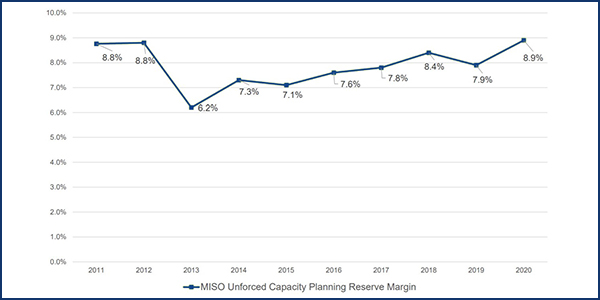By Amanda Durish Cook
MISO estimates it will need an 8.9% unforced capacity planning reserve margin for the 2020/21 planning year, a full percentage point above the current level, according to the RTO’s most recent annual loss-of-load expectation (LOLE) study.
The new margin will translate into an 18% planning reserve margin requirement on an installed capacity basis, compared with the current 17% target.
Resource mix and performance changes along with load profile and forecast changes drove the uptick, MISO said. The RTO reported larger resource sizes and a continued trend of increasing forced outages coupled with decreased forecasted load but more peak demand days across the year.
“In this year’s LOLE study, the changing resource mix and performance of the resource mix have contributed the most to the increase in the [planning reserve margin],” MISO Manager of Probabilistic Resource Studies Lynn Hecker told stakeholders at the Resource Adequacy Subcommittee’s meeting Wednesday. Hecker said that while the number of resources in MISO has decreased, the average size of units has increased.
“This shouldn’t be surprising to anyone because the PRM has been largely trending up because of changes in resource mix, rising forced outage rates and load uncertainty,” Hecker said.
MISO’s unforced planning reserve margin has generally risen since 2013, growing from 6.2% to nearly 9%.
Hecker said Wisconsin’s Zone 2 and lower Michigan’s Zone 7 are projected to be the closest to reaching their respective forecasted local clearing requirements based on results from MISO’s 2019 resource adequacy survey with the Organization of MISO States. This year’s OMS-MISO survey predicted adequate reserves through 2022.
“We have regular conversation with states … about what we’re seeing. The whole purpose of this conversation is us saying, ‘Hey, we see some zones that are going to be tight.’ We want to put it out there,” Director of Resource Adequacy Coordination Matt Ellis said.
Customized Energy Solutions’ Ted Kuhn said reserve margins are becoming so high that they may threaten the value proposition MISO touts to justify membership. Kuhn asked the RTO to conduct an analysis to show its recommendations are still more beneficial than maintaining individualized systems.
MISO and stakeholders may consider increasing the number meetings of the Loss of Load Expectation Working Group (LOLEWG) next year as the RTO mulls using a seasonal capacity construct. Should that happen, the LOLE study — which is based on an annual summer peak — may require fundamental changes. The LOLEWG currently meets about five or six times per year.




